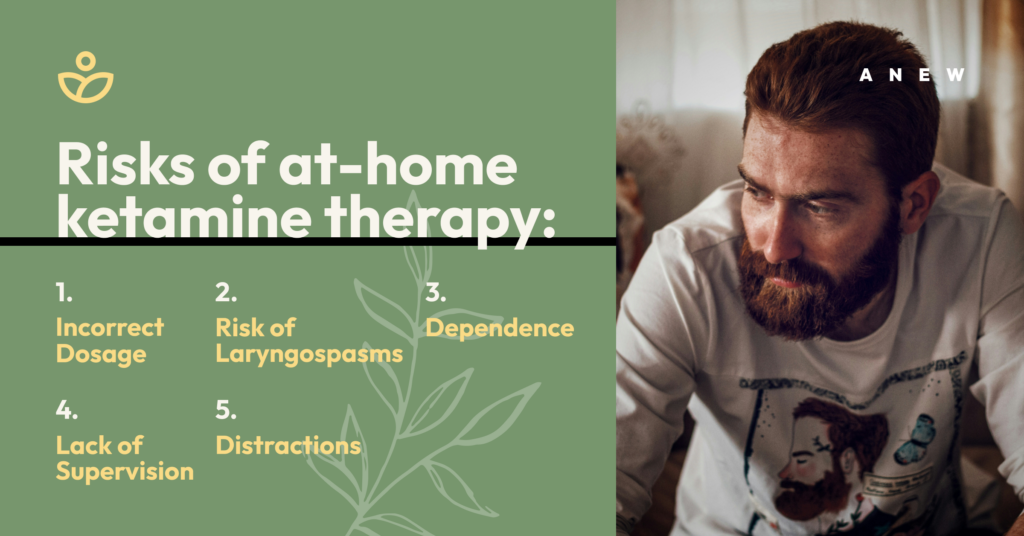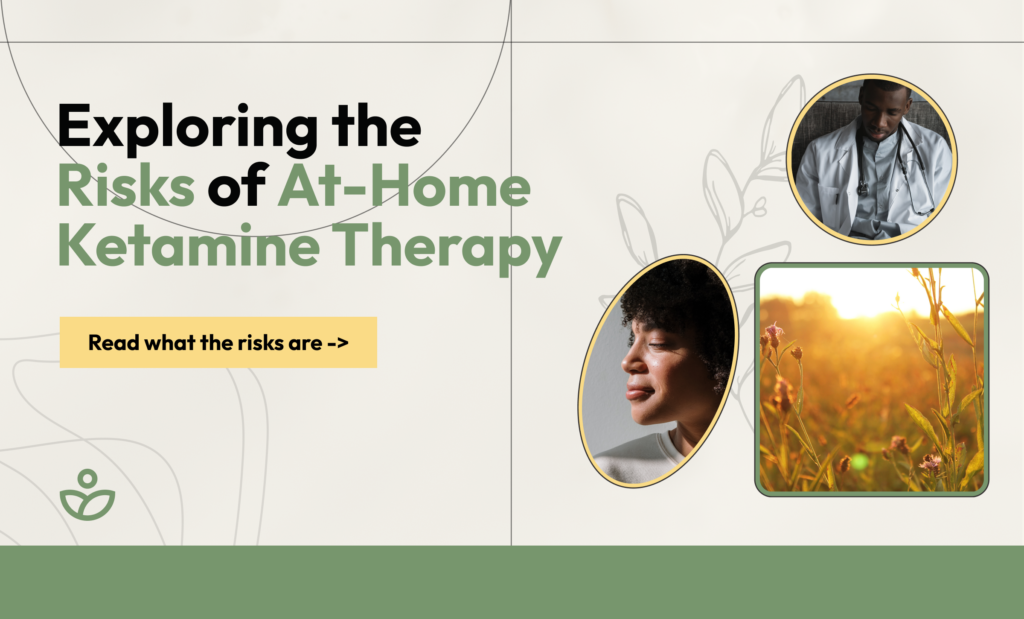In recent years, at-home ketamine therapy has become a popular option for treating mental health conditions like depression, anxiety, and PTSD. While the idea of receiving treatment in the comfort of your own home may sound appealing, it’s important to consider the risks and drawbacks before deciding if this approach is right for you.
Here are some key considerations regarding at-home ketamine therapy:
- Self-administration risks: Without professional oversight, there’s a chance of incorrect dosing or misuse.
- Physical health risks: Adverse effects like laryngospasms can be serious or even life-threatening.
- Mental health risks: Dependence and possible negative psychological effects require expert monitoring.
- Lack of supervision: Without a clinician present, immediate medical assistance in emergencies isn’t available.
- Uncontrolled environments: Home settings might have distractions that could impact your experience and the effectiveness of the treatment.
Making informed decisions about mental health treatments is crucial, and safety should always be a top priority. While at-home ketamine therapy offers convenience, it’s important to recognize that the risks associated with self-administration might outweigh this benefit. Alternatives like SPRAVATOⓇ nasal spray or intramuscular (IM) ketamine therapy provide a safer, more controlled environment with professional supervision and precise dosage management, ensuring both effectiveness and patient well-being.

The Rise of At-Home Ketamine Therapy
The COVID-19 pandemic changed the way many people access healthcare. With the increase in telehealth services, receiving treatments at home became more common. This shift led to the popularity of at-home ketamine therapy, where providers offer sublingual ketamine tablets delivered directly to patients. They use telehealth protocols to guide individuals, promising convenience and rapid relief from mental health issues like depression and anxiety.
While these services offer guidelines on how to use ketamine safely, including instructions on dosage and timing, it’s important to be aware of the potential risks that come with self-administration without direct professional supervision.
Potential Dangers of At-Home Ketamine Use
Real-Life Incidents Highlighting the Risks
While at-home ketamine therapy may seem convenient, there have been serious and tragic outcomes associated with its unsupervised use. Here are some real-life examples that illustrate the potential dangers:
- Case 1: A 36-year-old man tragically lost his life due to a fatal laryngospasm after taking a 350 mg dose of sublingual ketamine. Without immediate medical assistance, this adverse reaction became life-threatening.
- Case 2: A 28-year-old woman with a history of hyper-reactive airways opted for sublingual ketamine because of financial constraints. Sadly, her daily use led to asphyxiation, leaving behind her young son.
- Case 3: A 20-year-old man suffered a severe anoxic injury after aspirating vomit following his first dose of sublingual ketamine. His mother, a nurse, discovered him in a critical state, leading to anticipated lifelong health challenges.
These incidents highlight the critical importance of professional supervision during ketamine therapy. The absence of immediate medical support contributed to catastrophic consequences that might have been prevented in a controlled clinical setting.
Searching for the best ketamine clinic in Utah? Anew Therapy offers expert care and proven results. Schedule your free intake appointment today.
Research and Findings
A survey conducted in 2023 highlighted concerns about the misuse of at-home ketamine therapy. It found that a shocking 55% of individuals who tried at-home treatments exceeded the recommended dose, either accidentally or intentionally. This raises serious concerns about the risk of dependency and underscores the critical need for professional supervision.The report also highlights that combining psychotherapy with ketamine treatment isn’t just beneficial—it could be crucial. Without the proper guidance and continuous oversight that therapy provides, patients may be more vulnerable to addiction and other adverse effects. Professional involvement ensures that ketamine is used safely and effectively, maximizing its therapeutic benefits while minimizing potential risks.

It seems as if the growing trend of at-home ketamine therapy has created some confusion within the medical community. In some cases, practitioners might prescribe this treatment without fully grasping its associated risks, inadvertently putting patient safety at stake. This situation emphasizes the need for clearer guidelines and more education for both healthcare providers and patients. By improving understanding of ketamine’s uses and risks, we can promote more informed and responsible treatment practices.
Optimal Alternatives to Sublingual Ketamine Therapy
Benefits of In-Clinic Ketamine Therapy
When considering ketamine therapy, options like SPRAVATOⓇ (esketamine nasal spray) and intramuscular (IM) administration offer several advantages over at-home sublingual methods.
- SPRAVATOⓇ is an FDA-approved esketamine nasal spray for treatment-resistant depression. Administered in a medical office, patients are observed for a period after administration to ensure safety and effectiveness. This method is often covered by insurance, making it a cost-effective option.
- Traditional ketamine therapy involves administering ketamine via injection into a muscle (IM) or directly into the bloodstream (IV). These methods are provided in a clinical setting, offering a high level of safety and monitoring.
Comparing At-Home and In-Clinic Treatments
At-home ketamine therapy, such as sublingual tablets, may seem convenient. However, it comes with significant risks, including severe side effects and lack of immediate medical supervision.
In-clinic treatments, on the other hand, offer several benefits:
- Professional Supervision: Medical professionals monitor patients throughout the treatment, ready to respond to any adverse reactions.
- Precise Dosage Control: IM and IV methods allow for exact dosing, reducing the risk of overdose or underdose.
- Immediate Medical Assistance: In case of complications, immediate medical support is available.
- Enhanced Effectiveness: Research indicates that in-clinic treatments can be more effective due to the controlled environment and professional support.
- Support from Trained Professionals: REMS-certified treatment centers ensure patient safety and treatment efficacy.
Cost Considerations
Although at-home ketamine therapy may appear less expensive initially, the potential costs associated with adverse effects and less effective treatment can add up. In contrast, in-clinic treatments like SPRAVATOⓇ are often covered by insurance, potentially making them a more economical choice over time.
Long-Term Outcomes
In-clinic ketamine therapy offers comprehensive care and professional supervision, which can contribute to better long-term outcomes compared to at-home use. The controlled environment ensures accurate dosing, immediate management of any adverse effects, and the integration of psychotherapy, all of which can enhance the effectiveness of the treatment. Clinicians can personalize treatment plans and adjust protocols based on individual progress, potentially improving long-term results.
Studies have shown that patients receiving ketamine therapy under medical supervision often experience rapid and significant reductions in depressive symptoms, with some achieving remission lasting several weeks to months. This sustained improvement can significantly enhance a patient’s quality of life.
Conclusion
When it comes to mental health treatment, prioritizing safety and professional guidance is essential. While at-home ketamine therapy might offer convenience, the potential risks may outweigh the benefits. Choosing professional, in-clinic treatments ensures a safer, more effective path to mental health.
At Anew Therapy Utah, we’re committed to providing a holistic approach to mental health care. Our patient-centered treatment plans focus on treating the whole person, not just the symptoms. We offer IM ketamine therapy as well as SPRAVATOⓇ—an FDA-approved esketamine nasal spray for treatment-resistant depression. These treatments are administered in a comfortable, controlled clinical environment, ensuring your safety and well-being at all times.
Rapid Symptom Relief
One of the primary benefits of clinical ketamine therapy is rapid symptom relief. Unlike traditional antidepressants that may take weeks to show effects, IM ketamine can provide relief within hours. This is particularly beneficial for individuals struggling with severe depression, anxiety, or PTSD.

Anew Therapy’s Approach
Our approach at Anew Therapy Utah is customized to meet your unique needs. We work closely with you to develop a treatment plan that aligns with your goals and circumstances. This patient-centered approach ensures that you receive the most effective care possible, guided by experienced healthcare professionals.
We don’t just focus on the symptoms; we treat the whole person. By addressing the root causes of mental health issues, we aim to provide lasting relief and improved quality of life. If you are interested in learning more about how we may be able to help you, schedule a free consultation today

